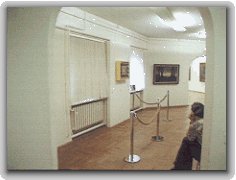


is an interactive work of art. A computer registers the visitor`s position in front of the monitor by means of light sensors. The software also processes variables such as time, date, velocity, etc. Using a pool of ca. 1,000 variations (of the portrait) and texts, the portrait changes in appearance in accordance with the variables. Thus each viewer gets his/her own personal story and a dialogue between him/her and the portrait can grow. As long as the visitor stays outside the range of the sensors, the picture shown is the standard portrait.
Even though the general state of repair of the actual painting is not very good, the stoic expression and strength of character in the young man's face is remarkable.
Jan van Halen - is the name of the subject of the portrait, Brügge 1432 - which information can be found (in Dutch) on the frame, fully preserved so that the identity of the subject is beyond question.
But who was this unknown master from Brugge?
The painting`s most striking feature is the man`s piercing gaze - which is penetratingly and intensely focused on the viewer. In this feature the painter dared something never before seen in Dutch painting. A comparison with a similar treatment is Jan van Eyck`s portrait "Man with Red Turban".
A colleague from Antwerp speculates that Jan van Eyck is indeed the painter of the "Young Man...". But there is no corroborative evidence and these speculations may well be attributable to youthful enthusiasm, rather than to disciplined research.
What we are nonetheless left with is this beautifully crafted portrait.
The young man turns his face to the viewer and looks coolly from within the picture: the face of a rebel, dissatisfied both with himself and with his circumstances. Despite the typical attire of a mail-coachman from the beginning of the 15th century the subject is elevated through the symmetry and pure formality of the treatment. From within the picture, the slightly excessive nostrils of the young man dominate to such an extent that he seems not only to look directly at the viewer but also to inhale him/her, sniffing as it were.
The strength and originality of the composition cannot possibly be overrated. For the first time in the history of painting the attempt to free the picture from its viewer is manifest. Up to that time, those who stood before a work of art could inspect it, judge it as good or bad, or perhaps not even so much as look at it. Now, with this portrait by an unknown master from Brugge, the painting was given the opportunity to turn the tables. It could now also examine its viewer. At last a dialogue becomes possible, a true coming together of the painting and its human counterpart whereby the interests of the painting are no longer helplessly at the mercy of the whims of its recipient.
Johannes Strahl - Bonner Kunstverein - how a young man with cap stopped the decay of the culture of conversation
The following footnotes are supposed to be a comedy of manners between words and science with the title: "Man sieht nur (...) weiß" (One sees only what one knows).
It was so lovely. Sauntering over polished parquet in tastefully decorated showrooms, letting one's eye wander over the exquisite specimens collected over many decades of cultivated activity, whilst revealing to one's attractive and intelligent companion that world full of deep thought and sweet feelings that art exuded back in those days. The gallery on the upper storey was the place of the most refined conversation, containing some of the greatest human pleasures.
Today it's a service. When you have just passed the older exhibits and have not yet reached the remarkable expressionists' dome', you are informed by notice boards about the history of the gallery, tabular reports of the curator's activities.
Occasionally a guided tour hurries by, the guide pointing out exactly where one should look and which interpretation thereto: the end of the 20th century.
Probably, it would not have been otherwise possible. Because those tasteful and well informed entertainers (benefiting from free time) have either died out or became too expensive, conversation had indeed become machine-made. One of those useful computers, connected to a flat screen and a gilded frame, entered into a refined conversation with the visitor - and up to now , struggling with what the experts call `the mediation of art`. He may well have won more friends than any others. How can a machine that has now become a picture, do it ? Building up the contact with the visitor so sensitively, smiling the right words into the right people's faces, even in Japanese? Is it the young man's natural aura or his simple and plain looks that wins their hearts ? And he knows so much about pictures, painters, and, above all, their audience! Just like in real life, though, you should not get too close to him, otherwise he will take fright. The moment the crowd presses round him like a herd he becomes silent. He waits and observes until the noise dies down and until his gestures and words can again be intelligible and communicable.

